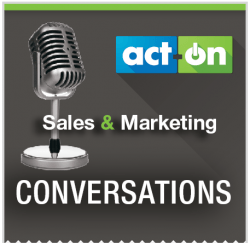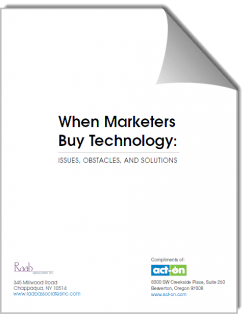Editor’s Note: David Raab has thirty years’ experience as a marketer, consultant, speaker, and analyst. He’s the author of The Marketing Performance Measurement Toolkit, and the Raab Association’s reports and guides, including the B2B marketing automation vendor selection tool, the VEST report. You can keep up with David at his blog, Customer Experience Matrix. Atri Chatterjee is Chief Marketing Officer of ZScaler.* They held a three-part conversation which covered the obstacles to buying technology; common mistakes in buying technology; and best practices in buying technology. This blog post is an edited transcript of the second part: Mistakes. You can listen to the Conversation on the audio player below.
[powerpress]
ATRI: David, the last time we talked about why it was hard for people trained as marketers to make the right decisions about technology. The upshot was the most fundamental error marketers make is not really understanding their own business needs in enough detail to have a basis for evaluating technology solutions.
The first mistake: not understanding your business requirements
 DAVID: I think that’s right. We’ve done research that backs up the conclusion. What happens is that if people don’t have real requirements, they still have to make a decision based on something else. So they make a decision based on the interface, or who has a good sales person, or tells a good story, or whatever. It’s not that they’re being irresponsible; they’re making a decision based on whatever sort of discriminating factors they can come up with.
DAVID: I think that’s right. We’ve done research that backs up the conclusion. What happens is that if people don’t have real requirements, they still have to make a decision based on something else. So they make a decision based on the interface, or who has a good sales person, or tells a good story, or whatever. It’s not that they’re being irresponsible; they’re making a decision based on whatever sort of discriminating factors they can come up with.
But unless you start with real requirements, you’re going to end up making a decision based on something. I have a slide where you see somebody in one of these huge stretch limos, and he’s trying to go down one of the streets in San Francisco where there are steps. Of course the limo gets hung up on a hump, because it doesn’t have the clearance to get over the steps.
To me, that’s bad requirements. The guy probably spent time looking at the limo, finding if the seats were comfortable, what was going to be in the bar, could it hold his 20 closest friends and all that – when his real requirement was to have enough clearance to get over the hump in the street. So it wasn’t that he didn’t look for requirements; he just looked for the wrong requirements. And that’s [LAUGHTER] what marketers do. They just don’t know what the real requirements are, so they end up looking for something else.
ATRI: You’ve probably seen your fair share of all of these different types of issues that come up as a result of setting up requirements poorly. Can you give us an idea of some specific ways in which things go wrong when marketers are looking to procure a system?
DAVID: Unsupervised marketers can be very dangerous when it comes to buying systems, I think, because they tend to buy things based on the wrong criteria.
The number one mistake, and we see it over and over, is that they think all systems are roughly the same. This is compounded if they don’t understand their own individual requirements. Too often they think, “Well, at the end of the day I’m not that different from anybody else, and my requirements are going to be kind of standard requirements, so I’ll pretty much assume that any of the top three or top five systems will do what I need, because that’s probably what they do.”
And so they assume the systems are all much the same. And then they’ll decide to buy based on price or on ease of use. Those are the two things that you find are really the most common selection criteria. Well price and ease of use really aren’t the most important. Price is absolutely the stupidest thing to buy on, to be blunt. Because if it doesn’t work –
Buying on price or ease of use is a mistake
ATRI: That’s very interesting, that you say that about price. I’m assuming that’s because really when you look at it, the price is a very small part of the entire cost of ownership of a system like this. Is that right?
DAVID: Exactly right. If it’s inefficient then you’re going to spend more in labor. Obviously if it doesn’t do the job, then your opportunity cost of doing poor marketing is going to way outweigh the actual price. And you’re right, even the operating cost of the software is nothing compared to the cost of the staff to run it. Ease of use, you can make a little stronger case for. But even there, if it doesn’t do something you need, it becomes unimportant.
One of the big problems we found in our research was integration. People were often very unhappy that the system they bought didn’t integrate with whatever it was supposed to integrate with. And they hadn’t been able to ascertain that in advance. It doesn’t matter if it’s easy to use, if it doesn’t integrate properly or if it doesn’t have some other feature that you need. So ease of use should be pretty far down the list.
 ATRI: These things not only ring true for me, but they align with what I hear when I talk to prospects and customers. You figure out what your requirements are, and try to find the system that best fits those requirements. Not necessarily the coolest system out there or the most popular system out there, but the one that fits those requirements the best. You also can’t get hung up on one or two favorite attributes, but look at a system in its entirety … because the cost of making the wrong decision can be extremely high.
ATRI: These things not only ring true for me, but they align with what I hear when I talk to prospects and customers. You figure out what your requirements are, and try to find the system that best fits those requirements. Not necessarily the coolest system out there or the most popular system out there, but the one that fits those requirements the best. You also can’t get hung up on one or two favorite attributes, but look at a system in its entirety … because the cost of making the wrong decision can be extremely high.
Obviously you want ease of use, no one wants a system that’s difficult to use. But really what you want is the platform that fits your needs the best. You have to check all the variables.
DAVID: That’s right. And just to poke a little more at ease of use, the issue is really usability. And usability has to do with fitness for purpose. It could be easy to use, but if it doesn’t do the right thing, it’s not very useable. So people often confuse the two. But it’s very critical to understand the difference. [LAUGHTER] Ease of use is not an absolute. It’s totally relative.
ATRI: That’s a great point. Well – we’ve certainly covered a lot of good information on ways that people can get it wrong. I’m looking forward to our next conversation, when we’re going to talk about how we get it right – the best practices that marketers can follow when going through the purchasing process.
DAVID: Yes, I think it’s important we leave people on a high note. So there is a solution, it’s not impossible. So everybody can cheer up until the next time.
ATRI: Thanks David. That’s for the next talk.
DAVID: Exactly. Thank you.
Look for the next post in the series: “David Raab and Atri Chatterjee: Best Practices for Buying Marketing Technology” next week.
Want to read the rest of this series?
Part 1: Why Buying Marketing Technology is Hard
Part 3: Best Practices for Buying Marketing Technology
Click here to get When Marketers Buy Technology:Issues, Obstacles, and Solutions
*At the time of these conversations, Atri was Act-On’s CMO.


